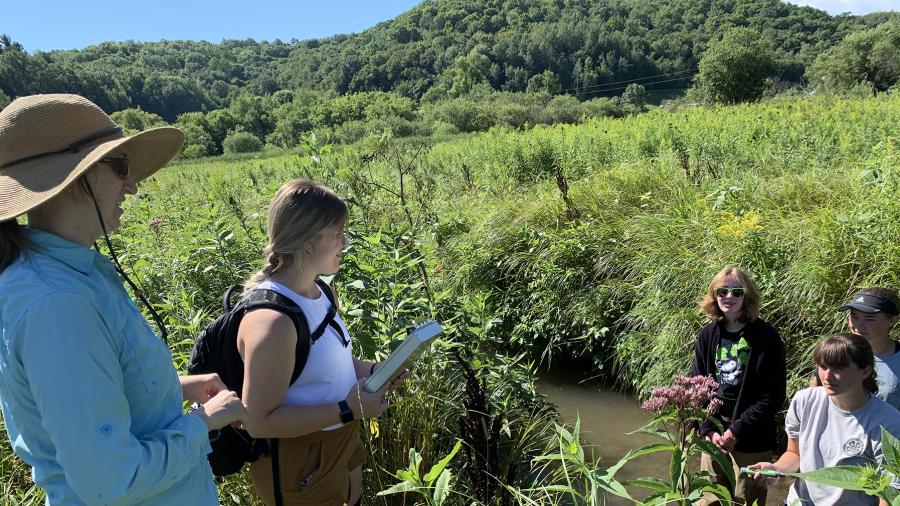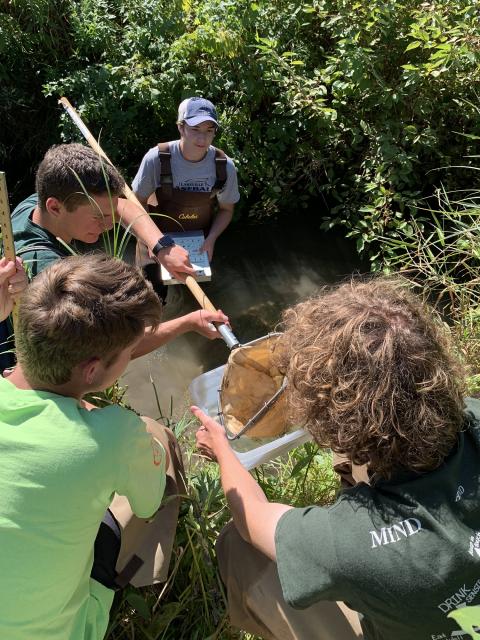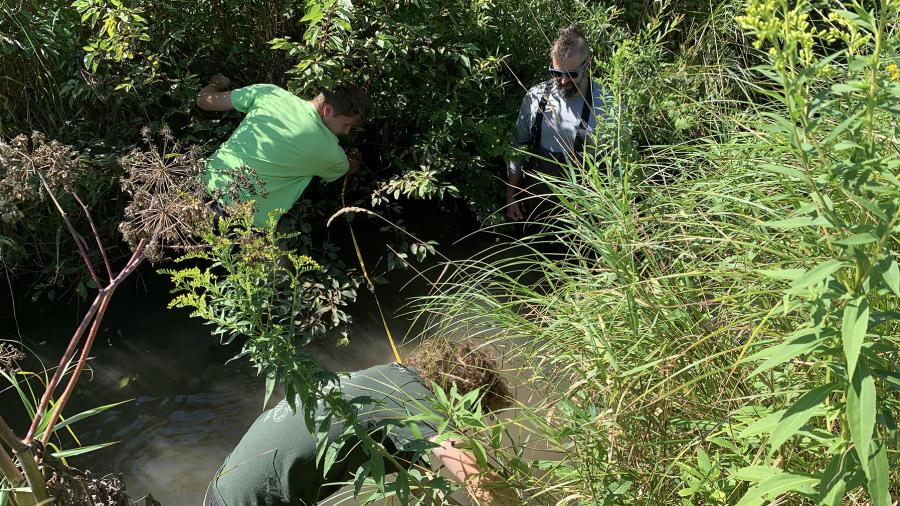Gilbert Creek in Dunn County slips through marshland and oak savanna between chest-high grasses and flowering plants. It can be hard to find and reach during the glory of midsummer.
Yet, one section of the slender creek — one of more than 12,000 rivers and streams in the state — was busy on a recent day as University of Wisconsin-Stout professors, UW-Stout students and high school students from Wisconsin paid a visit and gave it some special attention.
Thanks to two Freshwater Collaborative of Wisconsin grants, the group parted the grasses to find the stream, waded in, employed special testing equipment and collected data at the Gilbert Creek Fisheries and Wildlife Area.
One of the grants is the Red Cedar Basin Monitoring Program, nearly $72,000 UW-Stout received earlier this year to do work like at Gilbert Creek, where students checked for macroinvertebrates, measured for water clarity and volume, tested for ammonia and more.

The second FCW grant included professors and students from UW-Stout guiding six high school students for the day. The high school students were taking part in a weeklong program called Freshwater Science Field Experience in Western Wisconsin: The First Step in Developing a Skilled Workforce. Led by UW-Eau Claire, it included water-focused days at UW-Stout, UW-River Falls and UW-Oshkosh.
“This will help the high school students build awareness of the potential careers in this field and develop some skillsets,” said UW-Stout Associate Professor Keith Gilland, who teaches in the environmental science program.
The section of Gilbert Creek that the group tested was seven miles west of Menomonie on Highway 29, near Highway Q. That section previously had been restored; the new data will help show how well the restoration is holding up, Gilland said.
Gilland and other professors lead similar water testing in a general education biology course at UW-Stout. The data goes into a state database, which helps determine which bodies of water are most in need of attention and state funding. Also facilitating the project for UW-Stout was Professor Amanda Little.

The data also will be used to help develop a new 10-year plan for managing the Red Cedar River watershed, Gilland said.
Gilbert Creek flows into the Red Cedar River at Menomonie.
Red Cedar Basin Monitoring Program
The UW-Stout students working this summer and fall with the Red Cedar Basin Monitoring Program are Kal Breeden, of Lakeville, Minn., environmental science; Dylan Kostuch, of Amherst, applied science; and Britney Serafina, of Baldwin, environmental science.
They’ve also collected data from Galloway Creek and Wilson Creek in Menomonie, the Hay River and lakes Menomin and Tainter, as well as aerial imagery from previously restored sites and other sites with water quality issues where land use practices may be a factor.
“I’ve done some of this in class, but this experience has really solidified how this works and given me a better perspective of what I can do with my major,” said Serafina, who is majoring in environmental science after switching majors twice.
“This is one thing I’m thoroughly passionate about. I love the program. We don’t just sit in the classroom, but we get to go out in the field and do it,” she added.
Her long-term goal is to own a hydroponic farm where she can mass produce crops sustainably and not harm the soil or the environment.
High school grant program
Hometowns of the high school students who participated included Eau Claire, Chippewa Falls, Mauston and Greendale. They receive college and high school credits for participating.

“I’ve learned a lot more about stream flow and the structure of the stream, how the material on the bottom can help determine the health of the stream,” said Martin Wolf, from Mauston, who hopes to major in college in freshwater science, biology or a related major.
“I like this program a lot. It’s nice for students who love to do something with a lot of hands-on work,” Wolf said. “This is an awesome course for me.”
Students determined the volume of water at Gilbert Creek by measuring the width and depth of the creek and then the rate of flow at various points across the channel.
The presence of certain types of bugs in the stream can be an indicator of water quality and clarity, said Aaron Walczak, a teacher at Elk Mound High School who was helping direct the weeklong program.
When students were checking for bugs, UW-Stout Assistant Professor Nicole Hayes, biology, who guided half of the high school students during testing, wondered if they had found anything larger than one micron after they dipped a net into the stream.
Insect life helps support Gilbert Creek’s trout population.
Water clarity was determined by students when they filled a clear tube with creek water, then recorded where on the tube they could see a disk at the bottom.
When the creek area was restored, native grasses and sedges were planted to provide cover and nesting habitat for wildlife. The plants’ strong root systems reduce bank erosion and filter out pollutants. Flowering plants like goldenrods, bee balm and native shrubs like dogwoods and gooseberries have joined the herbaceous vegetation mix, Gilland said.
The high school students’ other experiences included testing on Lake Michigan during their day in Oshkosh and at Little Niagara Creek in Eau Claire.
In March, UW-Stout received $306,108 to lead eight projects for the Freshwater Collaborative of Wisconsin this year. A total of 42 projects were funded at 13 UW System campuses.
###






